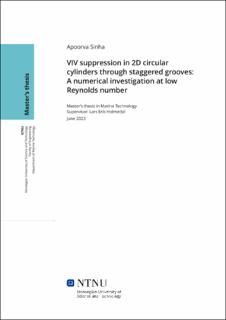| dc.description.abstract | Vortex-induced vibration (VIV), a ubiquitous fluid-structure interaction phenomenon, plays a crucial role in the operational safety and longevity of various engineering structures subjected to fluid flow, such as marine risers and offshore structures among others. The VIV phenomenon, characterized by the shedding of vortices and consequential oscillations of the structure, often induces fatigue and potential structural failure. Symmetric staggered grooves have recently emerged as a promising passive VIV control mechanism, but a comprehensive understanding and systematic exploration of their performance under varying conditions is yet to be achieved.
This thesis is devoted to an in-depth numerical analysis of the impact of symmetric staggered grooves on VIV suppression in a two-dimensional circular cylinder at a Reynolds number (Re) of 100. This research harnesses the integration of computational fluid dynamics (CFD) and computational structural dynamics (CSD) simulation tools to form a fluid-structure interaction (FSI) model using the open-source package OpenFOAM to model and simulate different grooved cylinder geometries with variations in groove depth, width, and position.
The first phase of the research focuses on the simulation and analysis of a smooth elastically mounted 2D cylinder, identifying the lock-in regime, a crucial aspect of VIV. This part of the research has already been conducted in a previous study that this work is a continuation of. Subsequently, the study systematically explores the relationship between groove parameters and VIV suppression performance in the grooved cylinder cases. A total of 36 grooved-cylinder configurations are analysed and the findings are reported. Intriguing correlations between VIV amplitudes and groove parameters were identified throughout these simulations. Notably, it was observed that as the groove width increased at a 90° position, VIV amplitudes reciprocally decreased. In contrast, VIV amplitudes escalated as the groove width increased at a 60° position. The grooves positioned at 90° registered a maximum reduction in cross-flow amplitude of 6.4% and an 11.1% reduction in in-line amplitude. On the other hand, for the grooves situated at a 60° position, there was a recorded maximum increase of 4.6% in cross-flow amplitude and a 6.4% increament in the in-line amplitude, when compared to the smooth cylinder case. Special attention was directed towards these specific groove positions based on intriguing observations from the analysis conducted on the smooth cylinder case. It was noted that these positions were characterised by regions of low vorticity, which are usually linked with flow separation. Therefore, it was expected that these positions, specifically at 60° and 90°, might have a significant effect on VIV suppression. This led to further investigation of how altering groove parameters at these positions could influence VIV reduction. Meanwhile, other positions displayed insignificant deviation from the smooth cylinder case, suggesting that the groove position plays a significant role in VIV suppression.
The present research dives deeper into the hydrodynamics around the cylinders and inside the grooves, encompassing analyses of vorticity distribution. The results contribute to enhancing the understanding of VIV mechanisms, particularly the influence of grooves on vortex shedding and fluid-structure interaction.
This comprehensive investigation provides insights into the design and optimization of grooves for efficient VIV suppression, thereby significantly contributing to the development of safer and more reliable engineering structures exposed to fluid flow. The findings of this study, especially the dependencies of VIV amplitudes on groove parameters, has the potential to have significant implications for engineering applications dealing with VIV-induced fatigue and failure.
Through this computational exploration, this thesis fills the existing research gap in the systematic study of symmetric staggered grooves for VIV suppression, providing a reference point for future studies and designs aiming to optimise VIV suppression techniques. The understanding derived from this research will pave the way for extending these investigations to three-dimensional structures and turbulent flows, further bolstering our capability to control VIV in a broader range of real-world applications. | |
